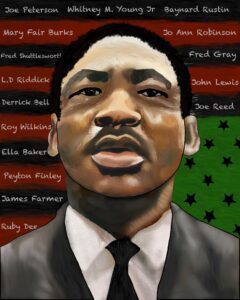By Candice Anderson, QA Analyst at DailyPay, Inc.
During my exploration of Martin Luther King Jr.’s life, seeking inspiration to contribute, I felt moved to craft this drawing. Every element is intentionally placed, and here, I aim to invite you into my creative journey, shedding light on significant aspects.
The drawing’s backdrop mirrors the colors of the Black Liberation Flag, birthed in 1920 as a response to an anti-Black song highlighting the absence of a flag representing the Black American community. Evolving into a powerful emblem, it proudly waves at protests, civil rights gatherings, and during MLK Day parades, signifying unity and resilience.
At the center of this artwork lies the portrait of Martin Luther King Jr., symbolizing his central role akin to being the face of the Civil Rights Movement for countless individuals. Committed to nonviolence on moral grounds, King fervently believed that “the Christian doctrine of love coupled with the Gandhian approach to nonviolence was one of the most potent weapons available to oppressed people in their struggle for freedom” (King, Stride, 79; Papers 5:422).
The flag behind the central piece bears numerous names — names of individuals who worked alongside King, contributing significantly to the change we witness today. While these names might not enjoy the same recognition as King’s, their dedicated efforts toward the cause are equally invaluable and deserving of acknowledgment. While King’s energy reverberated widely and his rhetoric inspired everyone, numerous other catalysts actively translated his words into impactful actions at the forefront of change.
Jo Ann Robinson
Jo Ann Robinson, an educator at Alabama State College, now Alabama State University, encountered verbal abuse for defying the segregated seating on a mostly empty city bus. Turning to her peers in the Women’s Political Council, Robinson proposed a boycott but was met with indifference, being told that such mistreatment was simply “a fact of life in Montgomery.” However, when Rosa Parks was arrested on December 1, 1955, for a similar act of defiance that led to Robinson’s expulsion from the bus, Robinson seized the moment to initiate her boycott. Collaborating with two Alabama State students and a mimeograph machine, she produced 35,000 flyers advocating for a boycott of the Montgomery bus system, a movement that endured for over a year. The successful launch of the boycott led to the formation of the Montgomery Improvement Association, with Reverend Martin Luther King Jr. assuming the presidency. Facing repercussions for supporting students who participated in the 1960 sit-ins, Robinson resigned from her teaching role at ASU. Her legacy lives on. In 2021, the ASU board of trustees honored her by renaming a residence hall, previously named after Alabama’s 39th Governor with ties to the Ku Klux Klan, to Jo Ann Robinson Hall.
Roy Wilkins
Roy Wilkins, as the Executive Director of The National Association for the Advancement of Colored People (NAACP), steered the organization toward its mission of securing equal rights for all Americans through peaceful and lawful means. Redirecting their efforts towards combating Jim Crow laws, the NAACP initiated the pivotal dismantling of segregation rules, notably exemplified in the landmark case of Brown v. Topeka Board of Education. Upon assuming his role in the early 1960s, Wilkins introduced fresh energy into the movement, advocating relentlessly for progressive action. His active involvement in historic events like the 1963 March on Washington and the 1965 Selma to Montgomery march amplified the momentum for change. His legacy lives on through various tributes: the renaming of The St. Paul Auditorium in 1985, the establishment of the Roy Wilkins Center for Human Relations and Social Justice at the University of Minnesota’s Hubert H. Humphrey School of Public Affairs in 1992, and the dedication of Roy Wilkins Park in St. Albans, Queens, New York, serving as a distinctive public and cultural landmark for the entire city.
Payton Finley
Payton Finley played a pioneering role in the establishment of Lincoln Normal School, one of the oldest Historically Black Colleges and Universities (HBCUs) in Marion, Alabama. He demonstrated relentless determination in elevating the institution’s status from a normal school to a recognized university. Following a devastating fire that devastated half of the campus, Finley actively advocated for relocating the school to Montgomery, Alabama, culminating in its transformation into the renowned Alabama State University. Today, his legacy lives on through residential buildings on campus that bear his name, a testament to his impactful contributions.
Fred Shuttlesworth
Fred Shuttlesworth, an Alabama State University graduate from the class of 1951, emerged as a prominent figure in the Civil Rights movement. Despite Alabama’s ban on NAACP activities, Shuttlesworth took on the role of Membership Chairman for the state chapter in 1956. He went on to establish the Alabama Christian Movement for Human Rights, focusing on desegregating the police force and actively participating in sit-ins targeting segregated lunch counters in 1960. His legacy lives on. In 2008, the Birmingham airport underwent an official name change to Birmingham–Shuttlesworth International Airport, honoring his contributions. Additionally, the Alabama State campus pays tribute to this distinguished former student by naming their Dining Hall after him.
These individuals are the often-overlooked champions of the civil rights movement. Their courage and dedication moved me to create this art piece because their efforts, alongside many others, lent vital support, action, and spurred the transformative change we see today in response to Reverend Dr. Martin Luther King Jr.’s powerful words.
Citations:
1 – Roy Wilkins. (2023, December 11). Wikipedia. https://en.wikipedia.org/wiki/Roy_Wilkins
2 – Lincoln Normal School. (2023, September 28). Wikipedia. https://en.wikipedia.org/wiki/Lincoln_Normal_School
3 – Peyton Finley. (2022, July 27). Wikipedia. https://en.wikipedia.org/wiki/Peyton_Finley
4 – Fred Shuttlesworth. (2024, January 7). Wikipedia. https://en.wikipedia.org/wiki/Fred_Shuttlesworth
5 – Jo Ann Robinson. (2024, January 4). Wikipedia. https://en.wikipedia.org/wiki/Jo_Ann_Robinson


































